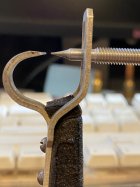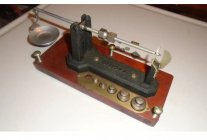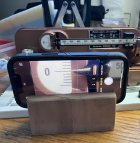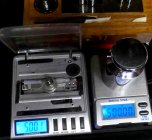Yeah, I agree. that FX120i is a great machine.
So how long does it actually take to cycle one load? Have you timed some to get an average? ie throw powder into pan, trickle to weight, remove pan and dump into cartridge?
Follow along with the video below to see how to install our site as a web app on your home screen.
Note: This feature may not be available in some browsers.
Yeah, I agree. that FX120i is a great machine.
Tesoro, I have not used one. Someone will chime in and let us know.So how long does it actually take to cycle one load? Have you timed some to get an average? ie throw powder into pan, trickle to weight, remove pan and dump into cartridge?
@Infrequent Shooter
Ever figure out which nickle was the heavy one?
The first thing one needs to do is figure out what you want the scale to do.
Make a list of weight values, tolerances, and speed of measurement that will make you happy.
Powder charges of 30gr, 50gr, 70 gr? Is +/- 1/10 grain good enough?
Sorting brass, 110gr, 150gr, 200gr, to the nearest 1/2gr?
Sorting bullets, 40gr, 80gr 112gr, 200gr, to the nearest 1/10 grain?
Maybe even sorting a box of 1000 primers to +/-0.02 grains?
The next thing to decide is how much you are ready to spend.
There are scales in the $20 range that might be good enough, maybe $50, $300, and then of course the more expensive ones. Maybe you want a scale with automated charging/trickle. Will it work for all the measurements you want to make? Would a two step weighing 'system' with a dispenser followed by a more precise digital scale? How about a cheap scale for less demanding work and a better one for weighing that really has to be spot on? A beam scale in good condition might work but sorting components would be a pain. A single scale for all measurements in the reloading room might not be the answer.
If your scale is not LINEAR, a full scale calibration without check weights tells you little.
A full scale calibration weight might be required or a digital scale might not complete the calibration but has little to do with accuracy at typical charge weights. Error in a 50 GRAM calibration weight that is 50 milligrams high or low, 49.950g to 50.050g (+/- 0.1%) will likely disappear when weighing powder charges. 30grains +/- 0.1 % due to full scale calibration error is +/- 0.03 grains. Zero drift (seen or hidden), linearity error, resolution and repeatability will likely be bigger than full scale calibration error. That's where check weights come in handy. Accuracy requirements for smaller check weights will be more stringent.
Be ready to figure grams to grains and percent of value. Look up weight tolerances. Better weights may cost more than your scale. Cheap Chinese magnetic steel weights, or old grain calibration sets might not be good enough. Stainless Steel non-magnetic weights of known value and treated gently will last MANY years, even without recalibration.
Good environmental conditions and having known Accurate and Stable (repeatable) check weights NEAR your target is an absolute necessity to check scale performance. You will NEED both check weights and calibration weights. You should probably try to have the ability to CHECK scale performance better than your accuracy requirements for normal use.
Using anything other than a check weight of KNOWN value will BITE you if something happens to the weight and you have to obtain another. Sorting and weighing aren't really the same thing.
Battery power and AC power might help troubleshooting drift and zero problems. Don't be afraid to occasionally hit the Tare/Zero button on cheaper scales.
With a cheapo scale, maybe a 150 pound granite block set in a sandbox, with a power conditioner (not just a surge protector), a wind shield, anti-static wrist straps, barefoot on a anti-static mat, temperature and humidity controlled environment, just might help.
@Infrequent Shooter
Ever figure out which nickle was the heavy one?
The first thing one needs to do is figure out what you want the scale to do.
Make a list of weight values, tolerances, and speed of measurement that will make you happy.
Powder charges of 30gr, 50gr, 70 gr? Is +/- 1/10 grain good enough?
Sorting brass, 110gr, 150gr, 200gr, to the nearest 1/2gr?
Sorting bullets, 40gr, 80gr 112gr, 200gr, to the nearest 1/10 grain?
Maybe even sorting a box of 1000 primers to +/-0.02 grains?
The next thing to decide is how much you are ready to spend.
There are scales in the $20 range that might be good enough, maybe $50, $300, and then of course the more expensive ones. Maybe you want a scale with automated charging/trickle. Will it work for all the measurements you want to make? Would a two step weighing 'system' with a dispenser followed by a more precise digital scale? How about a cheap scale for less demanding work and a better one for weighing that really has to be spot on? A beam scale in good condition might work but sorting components would be a pain. A single scale for all measurements in the reloading room might not be the answer.
If your scale is not LINEAR, a full scale calibration without check weights tells you little.
A full scale calibration weight might be required or a digital scale might not complete the calibration but has little to do with accuracy at typical charge weights. Error in a 50 GRAM calibration weight that is 50 milligrams high or low, 49.950g to 50.050g (+/- 0.1%) will likely disappear when weighing powder charges. 30grains +/- 0.1 % due to full scale calibration error is +/- 0.03 grains. Zero drift (seen or hidden), linearity error, resolution and repeatability will likely be bigger than full scale calibration error. That's where check weights come in handy. Accuracy requirements for smaller check weights will be more stringent.
Be ready to figure grams to grains and percent of value. Look up weight tolerances. Better weights may cost more than your scale. Cheap Chinese magnetic steel weights, or old grain calibration sets might not be good enough. Stainless Steel non-magnetic weights of known value and treated gently will last MANY years, even without recalibration.
Good environmental conditions and having known Accurate and Stable (repeatable) check weights NEAR your target is an absolute necessity to check scale performance. You will NEED both check weights and calibration weights. You should probably try to have the ability to CHECK scale performance better than your accuracy requirements for normal use.
Using anything other than a check weight of KNOWN value will BITE you if something happens to the weight and you have to obtain another. Sorting and weighing aren't really the same thing.
Battery power and AC power might help troubleshooting drift and zero problems. Don't be afraid to occasionally hit the Tare/Zero button on cheaper scales.
With a cheapo scale, maybe a 150 pound granite block set in a sandbox, with a power conditioner (not just a surge protector), a wind shield, anti-static wrist straps, barefoot on a anti-static mat, temperature and humidity controlled environment, just might help.

Neat scale! I just bought this one on ebay for 40 bucks delivered.View attachment 1498592
Rocketvapor, according to this balance the nickel commemorative appears to be lighter. Wow, took me about 30 minutes. This is an old Pacific scale, balance only, no markings. I had to close the door to my office to avoid draft. Amazingly delicate. The weights are labeled Pacific Grain Weights and come in a small tin. I hope I got it right.
Duralumin Pacific Weights on the second little tin. Beautiful little contraption.

I would like to know the time comparison. I could do around 200 an hour with my beam scale set up but rarely, if ever, do more than 1/2 hr at a time; or 50. I don’t there is much subjective to it if view angle is fixed and trickle up is done consistently.I have converted to a fx120 from previously a beam scale guy, I use the Harrell’s thrower, and dandy trickler. I dump a load very close then trickle up a few kernels. The balance display is quite a bit faster than a beam scale dampening and the viewing is not subjective as with a beam scale.

I would like to know the time comparison. I can do around 200 an hour with my beam scale set up but rarely do more than 1/2 hr at a time; or 50. I don’t there is much subjective to it if view angle is fixed and trickle up is done consistently.I have converted to a fx120 from previously a beam scale guy, I use the Harrell’s thrower, and dandy trickler. I dump a load very close then trickle up a few kernels. The balance display is quite a bit faster than a beam scale dampening and the viewing is not subjective as with a beam scale.
Be fun to clean up and see how tunable and repetitive it is. gun room decor!Great taste. I like the wood base. Mine is not attached to anything. very nice setup. leveling screws too!
I have no idea what the time comparison would be, but it picks up trickler grains almost instantly.I would like to know the time comparison. I can do around 200 an hour with my beam scale set up but rarely do more than 1/2 hr at a time; or 50. I don’t there is much subjective to it if view angle is fixed and trickle up is done consistently.
Be fun to clean up and see how tunable and repetitive it is. gun room decor!
I haven't. But must be sturdy:Just curious if anyone has used one of these.
| Weight Limit | 3000 Pounds |
I am going to a digital scale, but I am a sucker for a quality beam scale. I just bought a clean Ohaus 505 scale. What I am curious about isSure’ you can come up with different viewing methods that help the individual but for myself the beam scale just became a pain in the neck, literally.. as far as time’ i just shared my experience.
I am getting one of these this week.In addition to several other scales, I have one of these, which is an amazing value. Several people have bought them based on my recommendation and they are all of the same opinion. It is available on Amazon.
I think that one of the reason that this scale responds so well is that it is working at a higher percentage of its load limit. Load cells work by bending something and stretching something that varies in resistance with the amount of stretch. My theory is that if the load is small compared to the limit that the action will be less repeatable, but that is just my working theory.I have an OLD one. Accurate, but does have a little drift. Tares out OK.
Load cell is SMALL and Delicate.
View attachment 1499124

For those that don’t have this scale that was Grams measure, Grains will show as GN.This short video illustrates how quickly the fx120 resolves and displays weight.
Id be fairly confident in Lyman or Ohaus check weights.
Well that’s Cool, I learn something new every day.You are correct, the .00 GN mode resolves value just as quickly but in even numbers, I don’t recall seeing odd numbers in grain mode.

